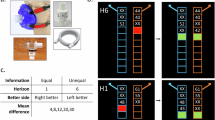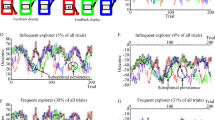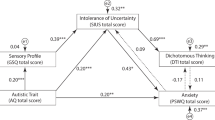Abstract
Anxiety has been related to decreased physical exploration, but past findings on the interaction between anxiety and exploration during decision making were inconclusive. Here we examined how latent factors of trait anxiety relate to different exploration strategies when facing volatility-induced uncertainty. Across two studies (total N = 985), we demonstrated that people used a hybrid of directed, random and undirected exploration strategies, which were respectively sensitive to relative uncertainty, total uncertainty and value difference. Trait somatic anxiety, that is, the propensity to experience physical symptoms of anxiety, was inversely correlated with directed exploration and undirected exploration, manifesting as a lesser likelihood for choosing the uncertain option and reducing choice stochasticity regardless of uncertainty. Somatic anxiety is also associated with underestimation of relative uncertainty. Together, these results reveal the selective role of trait somatic anxiety in modulating both uncertainty-driven and value-driven exploration strategies.
This is a preview of subscription content, access via your institution
Access options
Access Nature and 54 other Nature Portfolio journals
Get Nature+, our best-value online-access subscription
27,99 € / 30 days
cancel any time
Subscribe to this journal
Receive 12 digital issues and online access to articles
118,99 € per year
only 9,92 € per issue
Buy this article
- Purchase on SpringerLink
- Instant access to full article PDF
Prices may be subject to local taxes which are calculated during checkout




Similar content being viewed by others
Data availability
All de-identified data are publicly available at the Open Science Framework website: https://osf.io/y6urc/.
Code availability
The code used to fit belief update model, generate regression models and generate figures are publicly available at the Open Science Framework https://osf.io/y6urc/.
References
Lister, R. G. The use of a plus-maze to measure anxiety in the mouse. Psychopharmacology 92, 180–185 (1987).
Prut, L. & Belzung, C. The open field as a paradigm to measure the effects of drugs on anxiety-like behaviors: a review. Eur. J. Pharmacol. 463, 3–33 (2003).
Zweifel, L. S. et al. Activation of dopamine neurons is critical for aversive conditioning and prevention of generalized anxiety. Nat. Neurosci. 14, 620–626 (2011).
Britton, D. R. & Britton, K. T. A sensitive open field measure of anxiolytic drug activity. Pharmacol. Biochem. Behav. 15, 577–582 (1981).
Biedermann, S. V. et al. An elevated plus-maze in mixed reality for studying human anxiety-related behavior. BMC Biol. 15, 125 (2017).
Walz, N., Mühlberger, A. & Pauli, P. A human open field test reveals thigmotaxis related to agoraphobic fear. Biol. Psychiatry 80, 390–397 (2016).
Schulz, E. & Gershman, S. J. The algorithmic architecture of exploration in the human brain. Curr. Opin. Neurobiol. 55, 7–14 (2019).
Levinthal, D. A. From arms to trees: opportunity costs and path dependence and the exploration-exploitation tradeoff. Strategy Sci. 6, 331–337 (2021).
Grupe, D. W. & Nitschke, J. B. Uncertainty and anticipation in anxiety: an integrated neurobiological and psychological perspective. Nat. Rev. Neurosci. 14, 488–501 (2013).
Charpentier, C. J., Aylward, J., Roiser, J. P. & Robinson, O. J. Enhanced risk aversion, but not loss aversion, in unmedicated pathological anxiety. Biol. Psychiatry 81, 1014–1022 (2017).
Aberg, K. C., Toren, I. & Paz, R. A neural and behavioral trade-off between value and uncertainty underlies exploratory decisions in normative anxiety. Mol. Psychiatry 27, 1573–1587 (2022).
Bennett, D., Sutcliffe, K., Tan, N. P. J., Smillie, L. D. & Bode, S. Anxious and obsessive-compulsive traits are independently associated with valuation of noninstrumental information. J. Exp. Psychol. Gen. 150, 739–755 (2021).
Aylward, J. et al. Altered learning under uncertainty in unmedicated mood and anxiety disorders. Nat. Hum. Behav. 3, 1116–1123 (2019).
Daw, N. D., O’Doherty, J. P., Dayan, P., Seymour, B. & Dolan, R. J. Cortical substrates for exploratory decisions in humans. Nature 441, 876–879 (2006).
Gershman, S. J. Deconstructing the human algorithms for exploration. Cognition 173, 34–42 (2018).
Schwartenbeck, P. et al. Computational mechanisms of curiosity and goal-directed exploration. eLife 8, e41703 (2019).
Wilson, R. C., Geana, A., White, J. M., Ludvig, E. A. & Cohen, J. D. Humans use directed and random exploration to solve the explore–exploit dilemma. J. Exp. Psychol. Gen. 143, 2074–2081 (2014).
Wilson, R. C., Bonawitz, E., Costa, V. D. & Ebitz, R. B. Balancing exploration and exploitation with information and randomization. Curr. Opin. Behav. Sci. 38, 49–56 (2021).
Dubois, M. et al. Human complex exploration strategies are enriched by noradrenaline-modulated heuristics. eLife 10, e59907 (2021).
Auer, P. Using confidence bounds for exploitation-exploration trade-offs. J. Mach. Learn. Res. 3, 397–422 (2002).
Srinivas, N., Krause, A., Kakade, S. M. & Seeger, M. W. Information-theoretic regret bounds for Gaussian process optimization in the bandit setting. IEEE Trans. Inf. Theory 58, 3250–3265 (2012).
Thompson, W. R. On the likelihood that one unknown probability exceeds another in view of the evidence of two samples. Biometrika 25, 285–294 (1933).
Gershman, S. J. Uncertainty and exploration. Decision 6, 277–286 (2019).
Gershman, S. J. & Tzovaras, B. G. Dopaminergic genes are associated with both directed and random exploration. Neuropsychologia 120, 97–104 (2018).
Tomov, M. S., Truong, V. Q., Hundia, R. A. & Gershman, S. J. Dissociable neural correlates of uncertainty underlie different exploration strategies. Nat. Commun. 11, 1–12 (2020).
Piray, P. & Daw, N. D. A model for learning based on the joint estimation of stochasticity and volatility. Nat. Commun. 12, 1–16 (2021).
Beltzer, M. L., Adams, S., Beling, P. A. & Teachman, B. A. Social anxiety and dynamic social reinforcement learning in a volatile environment. Clin. Psychol. Sci. 7, 1372–1388 (2019).
Browning, M., Behrens, T. E., Jocham, G., O’Reilly, J. X. & Bishop, S. J. Anxious individuals have difficulty learning the causal statistics of aversive environments. Nat. Neurosci. 18, 590–596 (2015).
Gagne, C., Zika, O., Dayan, P. & Bishop, S. J. Impaired adaptation of learning to contingency volatility in internalizing psychopathology. eLife 9, e61387 (2020).
Hein, T. P., de Fockert, J. & Ruiz, M. H. State anxiety biases estimates of uncertainty and impairs reward learning in volatile environments. NeuroImage 224, 117424 (2021).
Huang, H., Thompson, W. & Paulus, M. P. Computational dysfunctions in anxiety: failure to differentiate signal from noise. Biol. Psychiatry 82, 440–446 (2017).
Pulcu, E. & Browning, M. Affective bias as a rational response to the statistics of rewards and punishments. eLife 6, e27879 (2017).
Pulcu, E. & Browning, M. The misestimation of uncertainty in affective disorders. Trends Cogn. Sci. 23, 865–875 (2019).
Buss, A. H. Two anxiety factors in psychiatric patients. J. Abnorm. Soc. Psychol. 65, 426–427 (1962).
Hamilton, M. A. X. The assessment of anxiety states by rating. Br. J. Med. Psychol. 32, 50–55 (1959).
Lang, P. J. The mechanics of desensitization and the laboratory study of human fear. Behavior Therapy: Appraisal and Status. New York: McGraw-Hill, 160–191 (1969).
Schwartz, G. E., Davidson, R. J. & Goleman, D. J. Patterning of cognitive and somatic processes in the self-regulation of anxiety: effects of meditation versus exercise. Psychosom. Med. 40, 321–328 (1978).
Wall, A. D. & Lee, E. B. What do anxiety scales really measure? An Item content analysis of self-report measures of anxiety. J. Psychopathol. Behav. Assess. https://doi.org/10.1007/s10862-022-09973-9 (2022).
DeGood, D. E. & Tait, R. C. The cognitive-somatic anxiety questionnaire: psychometric and validity data. J. Psychopathol. Behav. Assess. 9, 75–87 (1987).
Ree, M. J., French, D., MacLeod, C. & Locke, V. Distinguishing cognitive and somatic dimensions of state and trait anxiety: development and validation of the state-trait inventory for cognitive and somatic anxiety (STICSA). Behav. Cogn. Psychother. 36, 313–332 (2008).
Wise, T. & Dolan, R. J. Associations between aversive learning processes and transdiagnostic psychiatric symptoms in a general population sample. Nat. Commun. 11, 1–13 (2020).
Spielberger, C. D. Manual for the State-trait Anxiety Inventory (STAI Form Y), consuting Psychologists Palo Alto. Consulting Psychologists Press (1983)
Aitchison, L., Bang, D., Bahrami, B. & Latham, P. E. Doubly Bayesian analysis of confidence in perceptual decision-making. PLoS Comput. Biol. 11, e1004519 (2015).
Fleming, S. M. & Daw, N. D. Self-evaluation of decision-making: a general Bayesian framework for metacognitive computation. Psychol. Rev. 124, 91–114 (2017).
Xiang, Y., Graeber, T., Enke, B. & Gershman, S. J. Confidence and central tendency in perceptual judgment. Atten. Percept. Psychophys. 83, 3024–3034 (2021).
Zorowitz, S., Momennejad, I. & Daw, N. D. Anxiety, avoidance, and sequential evaluation. Comput. Psychiatr. 4, 1–17 (2020).
Mkrtchian, A., Aylward, J., Dayan, P., Roiser, J. P. & Robinson, O. J. Modeling avoidance in mood and anxiety disorders using reinforcement learning. Biol. Psychiatry 82, 532–539 (2017).
Smith, R. et al. Lower levels of directed exploration and reflective thinking are associated with greater anxiety and depression. Front. Psychiatry 12, 782136 (2022).
Zaller, I., Zorowitz, S. & Niv, Y. Information seeking on the horizons task does not predict anxious symptomatology. Biol. Psychiatry 89, S217–S218 (2021).
Meyer, T. J., Miller, M. L., Metzger, R. L. & Borkovec, T. D. Development and validation of the Penn State worry questionnaire. Behav. Res. Ther. 28, 487–495 (1990).
Sharp, P. B., Miller, G. A. & Heller, W. Transdiagnostic dimensions of anxiety: neural mechanisms, executive functions, and new directions. Int. J. Psychophysiol. 98, 365–377 (2015).
Diagnostic and Statistical Manual of Mental Disorders: DSM-5, Vol. 5 (American Psychiatric Association, 2013).
Kallai, J. et al. Spatial exploration behaviour in an extended labyrinth in patients with panic disorder and agoraphobia. Psychiatry Res. 149, 223–230 (2007).
Gillan, C. M. et al. Experimentally induced and real-world anxiety have no demonstrable effect on goal-directed behaviour. Psychol. Med. 51, 1467–1478 (2021).
Domschke, K., Stevens, S., Pfleiderer, B. & Gerlach, A. L. Interoceptive sensitivity in anxiety and anxiety disorders: an overview and integration of neurobiological findings. Clin. Psychol. Rev. 30, 1–11 (2010).
Ehlers, A. Cognitive factors in panic attacks: symptom probability and sensitivity. J. Cogn. Psychother. 5, 157–173 (1991).
Yoris, A. et al. The roles of interoceptive sensitivity and metacognitive interoception in panic. Behav. Brain Funct. 11, 1–6 (2015).
de Berker, A. O. et al. Computations of uncertainty mediate acute stress responses in humans. Nat. Commun. 7, 1–11 (2016).
FeldmanHall, O., Glimcher, P., Baker, A. L., NYU PROSPEC Collaboration & Phelps, E. A. The functional roles of the amygdala and prefrontal cortex in processing uncertainty. J. Cogn. Neurosci. 31, 1742–1754 (2019).
Miu, A. C., Heilman, R. M. & Houser, D. Anxiety impairs decision-making: psychophysiological evidence from an Iowa gambling task. Biol. Psychol. 77, 353–358 (2008).
Nassar, M. R. et al. Rational regulation of learning dynamics by pupil-linked arousal systems. Nat. Neurosci. 15, 1040–1046 (2012).
Bacow, T. L., May, J. E., Brody, L. R. & Pincus, D. B. Are there specific metacognitive processes associated with anxiety disorders in youth? Psychol. Res. Behav. Manage. 3, 81–90 (2010).
Calvo, M. G. & Miguel-Tobal, J. J. The anxiety response: concordance among components. Motiv. Emot. 22, 211–230 (1998).
Hoehn-Saric, R., McLeod, D. R. & Zimmerli, W. D. Symptoms and treatment responses of generalized anxiety disorder patients with high versus low levels of cardiovascular complaints. Am. J. Psychiatry 146, 854–859 (1989).
Lenow, J. K., Constantino, S. M., Daw, N. D. & Phelps, E. A. Chronic and acute stress promote overexploitation in serial decision making. J. Neurosci. 37, 5681–5689 (2017).
Nestadt, G. et al. Obsessive–compulsive disorder: subclassification based on co-morbidity. Psychol. Med. 39, 1491–1501 (2009).
Dorfman, H. M., Bhui, R., Hughes, B. L. & Gershman, S. J. Causal inference about good and bad outcomes. Psychol. Sci. 30, 516–525 (2019).
Speekenbrink, M. & Konstantinidis, E. Uncertainty and exploration in a restless bandit problem. Top. Cogn. Sci. 7, 351–367 (2015).
Knowles, K. A. & Olatunji, B. O. Specificity of trait anxiety in anxiety and depression: meta-analysis of the state-trait anxiety inventory. Clin. Psychol. Rev. 82, 101928 (2020).
Roberts, K. E., Hart, T. A. & Eastwood, J. D. Factor structure and validity of the State-Trait Inventory for Cognitive and Somatic Anxiety. Psychol. Assess. 28, 134–146 (2016).
Horn, J. L. A rationale and test for the number of factors in factor analysis. Psychometrika 30, 179–185 (1965).
Bartlett, M. S. The statistical conception of mental factors. Br. J. Psychol. 28, 97–104 (1937).
Revelle, W. psych: Procedures for Psychological, Psychometric, and Personality Research. R package version 2.2.3 (Northwestern University, 2022); https://CRAN.R-project.org/package=psych
Acknowledgements
We thank T. Rusch for help with data analysis, and members of the Phelps Lab and Gershman Lab for helpful discussions. This work was supported by the National Institute on Drug Abuse (Grant No. R01 DA042855 to E.A.P.). The funders had no role in the study design, data collection and analysis, decision to publish or preparation of the manuscript.
Author information
Authors and Affiliations
Contributions
H.F., S.J.G. and E.A.P. developed the study concept and designed the study. H.F. collected data and performed data analysis. H.F. interpreted the data under the supervision of S.J.G. and E.A.P. All authors wrote the manuscript and approved its final version for submission.
Corresponding author
Ethics declarations
Competing interests
The authors declare no competing interests.
Peer review
Peer review information
Nature Human Behaviour thanks Christoph Korn and the other, anonymous, reviewer(s) for their contribution to the peer review of this work. Peer reviewer reports are available.
Additional information
Publisher’s note Springer Nature remains neutral with regard to jurisdictional claims in published maps and institutional affiliations.
Supplementary information
Supplementary Information
Supplementary Methods, Results, Tables 1–11, Figs. 1–14 and References.
Rights and permissions
Springer Nature or its licensor holds exclusive rights to this article under a publishing agreement with the author(s) or other rightsholder(s); author self-archiving of the accepted manuscript version of this article is solely governed by the terms of such publishing agreement and applicable law.
About this article
Cite this article
Fan, H., Gershman, S.J. & Phelps, E.A. Trait somatic anxiety is associated with reduced directed exploration and underestimation of uncertainty. Nat Hum Behav 7, 102–113 (2023). https://doi.org/10.1038/s41562-022-01455-y
Received:
Accepted:
Published:
Issue Date:
DOI: https://doi.org/10.1038/s41562-022-01455-y
This article is cited by
-
Emotions and individual differences shape human foraging under threat
Nature Mental Health (2025)
-
Information seeking and the expected utility of information about COVID-19 can be associated with uncertainty and related attitudes
Scientific Reports (2025)
-
Directed exploration is reduced by an aversive interoceptive state induction in healthy individuals but not in those with affective disorders
Molecular Psychiatry (2025)
-
Individuals with methamphetamine use disorder show reduced directed exploration and learning rates independent of an aversive interoceptive state induction
Communications Psychology (2025)
-
Dynamic computational phenotyping of human cognition
Nature Human Behaviour (2024)



